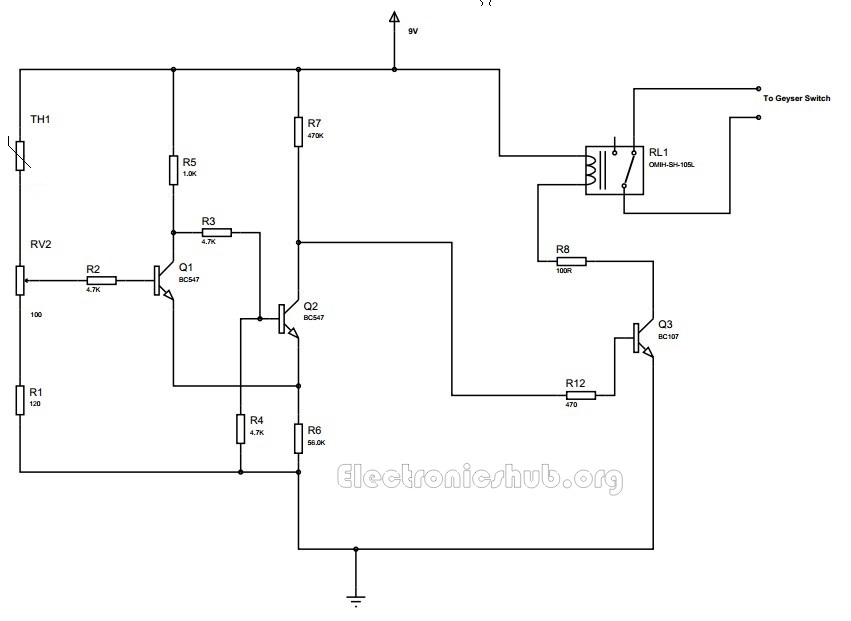This circuit is made to turn OFF geysers
as soon as our water gets hot and are ready for bathing. Although
modern domestic geysers have an inherent ability to detect the
temperature and turn On or Off automatically, this circuit helps us to
gain insight regarding how this is one in the geysers.
Hot Water Geyser Controller Circuit Diagram:
This circuit has a thermistor which is a
temperature sensing element that helps the circuit to determine the
temperature of the water. The thermistor is kept in contact with the
water while assembling the circuit on field. The property of the
thermistor is that its resistance is inversely proportional to the
temperature applied to it. It means that if the temperature in its
surroundings increases, the resistance offered by the thermistor
decreases. Similarly, if the temperature in the surroundings decreases,
the resistance offered by the thermistor increases. The name thermistor
is derived from thermal and resistor the meaning of which is implied and
the functionality of which can be easily understood from its name.
The thermistor in the circuit is
arranged in a voltage divider arrangement using which the variations in
the resistance of the thermistor is converted into the variations in
voltage values. These voltages are then used to switch a transistor to
ON state when the thermistor detects the water are sufficiently hot and
are ready to use.
The output voltage of the potentiometer
arrangement is given to the base of transistor BC547. The transistor
BC547 is a general purpose NPN transistor which is used as an electronic
switch in this circuit. When the thermistor senses a low temperature,
then the voltage divider arrangement provides a low voltage to the
switching transistor. Due to this, the transistor is in the off mode. If
the temperature reaches a value greater than a specific threshold, then
the transistor gets turned on. As we have discussed earlier, the
transistor acts as a switch which in turn turns on another transistor
which drives the relay. When the driving transistor turns on, the DC
current gets passed through the relay which turns the relay ON.
The relay is connected in the normally
closed mode in which it is normally closed and the circuit is opened
when the relay is turned ON. The circuit is closed means that the geyser
is turned on and the circuit is open means that the relay is turned
off. When the temperature is below the threshold value, the relay is off
and so the geyser will remain on. When the temperature reaches the
value equal to or exceeding the threshold value, then the relay turns on
which further breaks the connection and so the geyser turns off.

Greate pieces. Keep posting such kind of information on your blog.
ReplyDeleteIm really impressed by it.
Hello there, You’ve done an incredible job.
I will definitely digg it and personally recommend to my friends.
I’m sure they’ll be benefited from this site.
how many bottles of water are in a gallon
I like the valuable info you provide to your articles.
ReplyDeleteI will bookmark your blog and take a look at again here frequently.
I am reasonably sure I will be informed many new stuff proper right here! , Best of luck for the next!
You can check my site best geyser in INdia
is this post is true or not
ReplyDeleteHow many fluid ounces in a gallon of Water - cdhpl